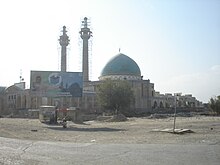Shia Islam in Afghanistan: Difference between revisions
→Ismailis: fix tag |
according to the sources provided |
||
| Line 1: | Line 1: | ||
[[File:Blue mosaic, Kabul.jpg|thumb|Masjid Jame in [[Kabul]] during construction in 2008, which is the largest [[Shi'a Islam|Shia]] [[mosque]] [[Afghanistan]].<ref>[http://www.flickr.com/photos/51400588@N06/4726044458/in/photostream/]</ref>]] |
[[File:Blue mosaic, Kabul.jpg|thumb|Masjid Jame in [[Kabul]] during construction in 2008, which is the largest [[Shi'a Islam|Shia]] [[mosque]] [[Afghanistan]].<ref>[http://www.flickr.com/photos/51400588@N06/4726044458/in/photostream/]</ref>]] |
||
'''Shi'a Islam''' is practiced by some |
'''Shi'a Islam''' is practiced by some 10-19% of the population of Afghanistan, with almost all of the remainder of the country practicing Sunni Islam.<ref name="PRC">{{cite web |url= http://pewforum.org/Muslim/Mapping-the-Global-Muslim-Population%286%29.aspx |title=Mapping the Global Muslim Population: A Report on the Size and Distribution of the World’s Muslim Population |quote=Afghanistan 10-15% Shi'a|publisher=[[Pew Research Center]] |date=October 7, 2009 |accessdate=2010-09-03}}</ref><ref name="PRCpdf">{{Cite book |url=http://pewforum.org/newassets/images/reports/Muslimpopulation/Muslimpopulation.pdf |title=Mapping the Global Muslim Population: A Report on the Size and Distribution of the World's Muslim Population |editor-last=Miller |editor-first=Tracy |publisher=Pew Research Center |format=PDF |date=October 2009 |accessdate=2010-09-03}}</ref><ref name="LoC">{{cite web |url=http://lcweb2.loc.gov/frd/cs/profiles/Afghanistan.pdf |title=Country Profile: Afghanistan |date=August 2008 |quote=''Religion: Virtually the entire population is Muslim. Between 80 and 85 percent of Muslims are Sunni and 15 to 19 percent, Shia.'' |publisher=[[Library of Congress Country Studies]] |accessdate=2010-09-03}}</ref><ref name="CIA">{{cite web |url=https://www.cia.gov/library/publications/the-world-factbook/docs/notesanddefs.html?countryName=Afghanistan&countryCode=af®ionCode=sas#2122 |title=Afghanistan |work=[[Central Intelligence Agency]] |publisher=[[The World Factbook]] |accessdate=2010-09-03}}</ref> Afghan Shi'a are primarily [[Twelver]] Shi'a, while a minority are [[Ismaili]]. |
||
==Twelver Shi'a== |
==Twelver Shi'a== |
||
Revision as of 19:50, 14 December 2011

Shi'a Islam is practiced by some 10-19% of the population of Afghanistan, with almost all of the remainder of the country practicing Sunni Islam.[2][3][4][5] Afghan Shi'a are primarily Twelver Shi'a, while a minority are Ismaili.
Twelver Shi'a
The majority of Afghan Shi'a are Twelvers, primarily of the Hazara ethnicity. The next-largest Twelver community are the Farsiwan of the western Herat and Farah provinces. Other, far smaller, Afghan Twelver communities include the Bayat and Qizilbash Turkic populations of Iranian origin, as well as the some of the Sayeds.
Ismailis
A smaller portion of Afghan Shi'a are Nizari Ismailis ("Seveners"); these populations include many of the Pamir language speakers of the northeastern portion of the country (predominantly in Badakhshan Province bordering Tajikistan).
Baghlan Province is also home to a Ismaili population, lead by a hereditary leadership, the Sayeds of Kayan. During the Soviet-Afghan War, 10,000 Ismaili militamen defended the Baghlan Ismaili stronghold of Kayan, having sided with the soviets due to differences with the Islamist opposition.[6] Unlike other Ismaili communities in Afghanistan and worldwide, the Baghlan Ismailis do not defer to the nominal leader of Ismailis worldwide, the Agha Khan, leading Naderi to be described as a "renegade local Ismaili leader".[7] This community, not accepted by the Sunni mainstream nor by the more powerful Twelver Shi'a Hazaras, has been historically discriminated against.[8]
See also
- Islam in Afghanistan
- Religion in Afghanistan
- Islamic conquest of Afghanistan
- Shi'a Islam in Pakistan
References
- ^ [1]
- ^ "Mapping the Global Muslim Population: A Report on the Size and Distribution of the World's Muslim Population". Pew Research Center. October 7, 2009. Retrieved 2010-09-03.
Afghanistan 10-15% Shi'a
- ^ Miller, Tracy, ed. (October 2009). Mapping the Global Muslim Population: A Report on the Size and Distribution of the World's Muslim Population (PDF). Pew Research Center. Retrieved 2010-09-03.
- ^ "Country Profile: Afghanistan" (PDF). Library of Congress Country Studies. August 2008. Retrieved 2010-09-03.
Religion: Virtually the entire population is Muslim. Between 80 and 85 percent of Muslims are Sunni and 15 to 19 percent, Shia.
- ^ "Afghanistan". Central Intelligence Agency. The World Factbook. Retrieved 2010-09-03.
- ^ Michael V. Bhatia; Mark Sedra (2008). Afghanistan, arms and conflict: armed groups, disarmament and security in a post-war society. Psychology Press. pp. 252–. ISBN 9780415453080. Retrieved 30 March 2011.
- ^ Hindokosh, May 2003 at UNHCR.org
- ^ http://books.google.com/books?id=laG03iJF7t8C&pg=PA160&dq=kayan+militia&hl=en&ei=wMvoTqqNKsPn0QHAh4jtCQ&sa=X&oi=book_result&ct=result&resnum=3&ved=0CEUQ6AEwAg#v=onepage&q=kayan%20militia&f=false
